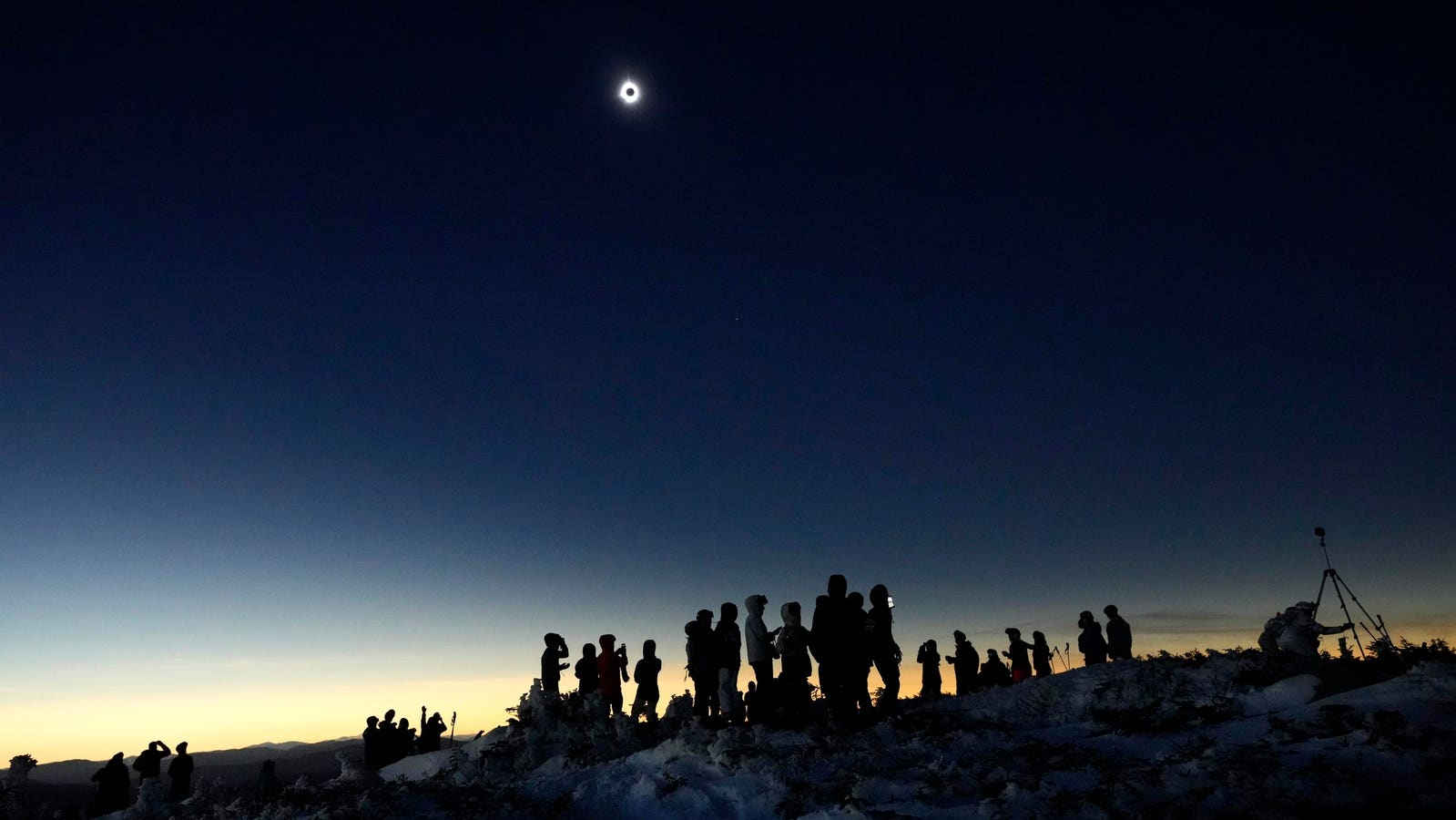Topline
It’s exactly one year until the next total solar eclipse. On Aug. 12, 2026, a short totality will be seen from a narrow path stretching from northern Russia through Greenland, Iceland and Spain. It will be the first total solar eclipse to touch mainland Spain since Aug. 11, 1999.
Skiers and hikers take in the view from the Appalachian Trail at the summit of Saddleback Mountain during the total solar eclipse, Monday, April 8, 2024, near Rangeley, Maine. (AP Photo/Robert F. Bukaty)
Copyright 2024 The Associated Press. All rights reserved.
Key Facts
The maximum totality for the total solar eclipse on Aug. 12, 2026, will be 2 minutes 18 seconds off the coast of western Iceland. During totality, the moon will perfectly block the sun, causing a brief 360-degree twilight, dropping temperatures and the chance to see the sun’s corona with the naked eye.
The path of totality will be, on average, 182 miles (293 kilometers) wide and 5,133 miles (8,260 kilometers) long, beginning as an eclipsed sunrise in northern Siberia, Russia and ending as an eclipsed sunset in Spain’s Balearic Islands in the Mediterranean Sea.
It will be the first total solar eclipse since April 8, 2024, when a long totality was seen from a path through Mexico, the U.S. and Canada.
The 2026 event will be the first in a series of three total solar eclipses in less than two years that cover both hemispheres. On Aug. 2, 2027, a total solar eclipse lasting up to 6 minutes 20 seconds — the longest remaining totality this century — will occur in North Africa, while on Jul. 22, 2028, up to 5 minutes 10 seconds of totality will occur in Australia and New Zealand.
The path of totality covers Greenland, Iceland and Spain on August 12, 2026.
Michael Zeiler/GreatAmericanEclipse.com
Where To Watch The 2026 Total Solar Eclipse
In eastern Greenland, over a dozen expedition-style cruise ships will take eclipse chasers into the Scoresby Sund/Kangertittivaq. Here, totality will last around 2 minutes during mid-afternoon. Western Iceland, including the capital Reykjavik, the Reykjanes Peninsula and the Snæfellsnes Peninsula, is in the path of totality. Totality will last up to 2 minutes and 13 seconds. In Spain, the path of totality moves from Galicia in the northwest, across Castilla y León, La Rioja and Aragón, to the east coast north of Valencia, just missing Madrid and Barcelona. Totality in Spain will last up to 1 minute and 49 seconds.
Northern Lights And The Perseids Meteor Shower
By chance, this total solar eclipse occurs not only on the same day as the peak night for the annual Perseid meteor shower, but also during a period when the Northern Lights season begins. While the latter will be restricted to those in Greenland and Iceland, the Perseid meteor shower will be observable from anywhere in the Northern Hemisphere.
How Often Does A Total Solar Eclipse Happen?
You’ll often hear that a total solar eclipse occurs “once every 18 months” somewhere on Earth, but that’s an average. At present, they occur 14 times every 18 years, though for a total solar eclipse to occur in a specific location on Earth is extremely rare. It’s about once in 366 years according to NASA, based on the paths of the 11,898 total solar eclipses from 2,000 B.C. to A.D. 3,000 A.D.








